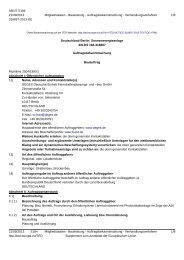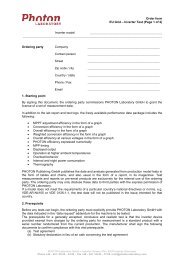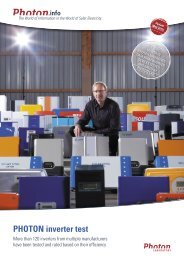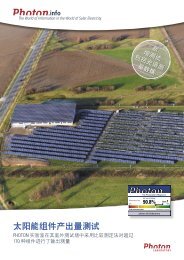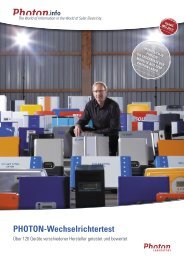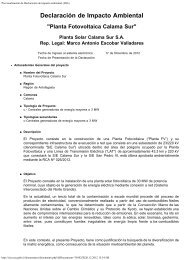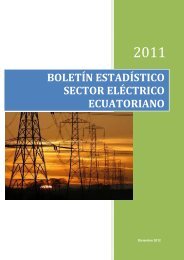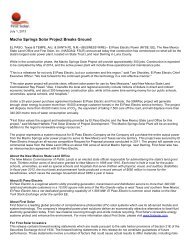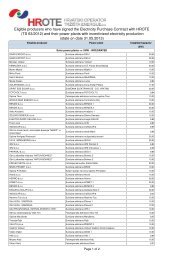INTRODUCTORY SPECIAL INTRODUCTORY ... - PHOTON Info
INTRODUCTORY SPECIAL INTRODUCTORY ... - PHOTON Info
INTRODUCTORY SPECIAL INTRODUCTORY ... - PHOTON Info
You also want an ePaper? Increase the reach of your titles
YUMPU automatically turns print PDFs into web optimized ePapers that Google loves.
36<br />
Politics<br />
(see table below). According to Laura<br />
Spanjian of the San Francisco Public<br />
Utilities Commission, the administra-<br />
tor of GoSolarSF, annual city installa-<br />
tions have more than quadrupled. In<br />
the first year of GoSolarSF, residents<br />
submitted 827 applications requesting<br />
$4.8 million in rebates, and San Fran-<br />
cisco committed to nearly 2 MW in resi-<br />
dential solar installations – an average<br />
subsidy of $2,400 per kW.<br />
The rebate may not seem like a lot of<br />
money when compared to the $30,000<br />
price tag for a residential system like<br />
Barry Wong’s. But the numbers show<br />
that the rebate was a tipping point of<br />
sorts. »It was clearly the right num-<br />
ber,« said SFPUC’s Spanjian. »People<br />
just needed a little more money to feel<br />
like they could afford it and they were<br />
getting a good return in a reasonable<br />
timeframe.« Moreover, many installers<br />
working in San Francisco coordinate<br />
the paperwork for the various incen-<br />
California Solar Initiative Application Count:<br />
City and County of San Francisco<br />
Applications<br />
140<br />
120<br />
100<br />
80<br />
60<br />
40<br />
20<br />
0<br />
Apr 07<br />
May 07<br />
Jun 07<br />
Jul 07<br />
Aug 07<br />
Sep 07<br />
Oct 07<br />
Nov 07<br />
Dec 07<br />
Jan 08<br />
Feb 08<br />
Mar 08<br />
Apr 08<br />
May 08<br />
2<br />
Feb 07<br />
Mar 07<br />
8 7<br />
16 19 20<br />
12 17<br />
26<br />
22<br />
13 12<br />
27<br />
117 117<br />
Solar spike: Applications from San Franciscans to the California Solar Initiative – the state’s solar rebate pro-<br />
gram – skyrocketed after July 2009 when the city launched GoSolarSF. In February 2009, San Francisco reduced<br />
the GoSolarSF incentive amounts, which may account for the sharp drop in applications at that time.<br />
29<br />
9<br />
14<br />
26<br />
62<br />
68<br />
93<br />
104<br />
111<br />
Jun 08<br />
Jul 08<br />
Aug 08<br />
Sep 08<br />
Oct 08<br />
Nov 08<br />
Dec 08<br />
Jan 09<br />
Feb 09<br />
Mar 09<br />
Apr 09<br />
May 09<br />
Jun 09<br />
Month<br />
»We met for 6 to 7 months and did something that task<br />
forces never do: We didn’t write a big report. Instead, we<br />
decided to implement what we recommended.«<br />
tives, so customers simply need to write<br />
a check for the attractive net price. But<br />
San Francisco’s solar market was not<br />
always the gold rush it has been since<br />
GoSolarSF began.<br />
A »Solar Task Force«<br />
to overcome barriers<br />
According to Phil Ting, Assessor-<br />
Recorder of San Francisco, the city was<br />
held back by a lack of leadership when it<br />
came to solar. »There were a lot of mega-<br />
words, but not a lot of megawatts,« said<br />
Ting. As of January 2007, Ting recalled,<br />
San Francisco was last among the nine<br />
Bay Area counties in per capita solar in-<br />
stallations. At that point, said Ting, the<br />
23<br />
27 27<br />
48<br />
35<br />
Source: San Francisco Public Utilities Commission<br />
city had 583 buildings with PV systems<br />
– roughly 5 MW – well short of the city’s<br />
goal of 10,000 solar roofs by 2010. Even<br />
when the State of California launched<br />
its successful rebate program in January<br />
2007, San Francisco solar installations<br />
failed to increase significantly. »We<br />
watched the number of installations in<br />
California double overnight because of<br />
that incentive program, but San Fran-<br />
cisco didn’t move,« said Ting.<br />
In an effort to change this situa-<br />
tion, Ting’s office convened the San<br />
Francisco Solar Task Force in 2007.<br />
This group of elected officials, solar<br />
installers, community leaders, activi-<br />
ties, non-profit organizations, and<br />
business people met monthly to inves-<br />
tigate why the city would not adopt so-<br />
lar, and how to jump-start the market.<br />
One major problem that the task force<br />
discovered: there were major bureau-<br />
cratic hurdles to doing solar business<br />
in San Francisco. »Permits (for solar<br />
installations) were taking six months<br />
to get approved. It was so bad that all<br />
the installers we had around the table<br />
had written off San Francisco,« said<br />
Ting. PV installers chose not to work or<br />
even market systems in San Francisco<br />
because they could do much better in<br />
other Bay Area cities – like San Rafael<br />
and San Jose – with more streamlined<br />
permitting processes.<br />
Task force members went right to the<br />
heart of the matter by working with the<br />
municipal permit agencies – the plan-<br />
ning, building, and fire departments<br />
– to streamline the solar installation<br />
process. According to Ting, the solar<br />
installers on the task force – including<br />
Akeena Solar, Occidental Power, and<br />
Luminalt – helped to lead this effort,<br />
since they are the ones who handle<br />
the day-to-day project logistics. Ting is<br />
pleased with the results: »Now, 95 per-<br />
November 2009



